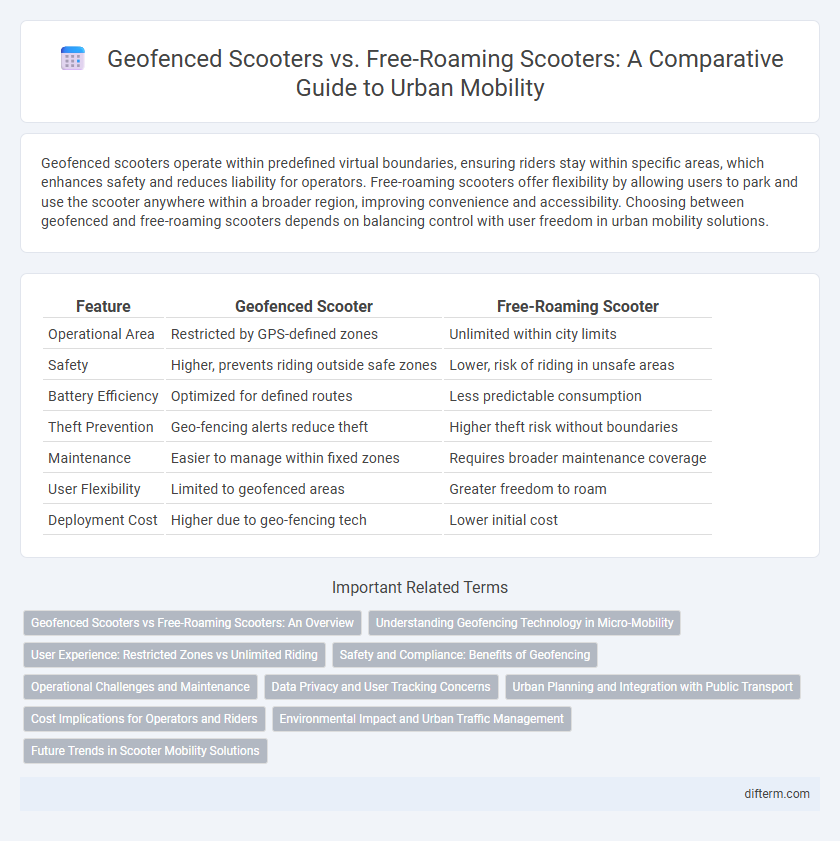Geofenced scooters operate within predefined virtual boundaries, ensuring riders stay within specific areas, which enhances safety and reduces liability for operators. Free-roaming scooters offer flexibility by allowing users to park and use the scooter anywhere within a broader region, improving convenience and accessibility. Choosing between geofenced and free-roaming scooters depends on balancing control with user freedom in urban mobility solutions.
Table of Comparison
| Feature | Geofenced Scooter | Free-Roaming Scooter |
|---|---|---|
| Operational Area | Restricted by GPS-defined zones | Unlimited within city limits |
| Safety | Higher, prevents riding outside safe zones | Lower, risk of riding in unsafe areas |
| Battery Efficiency | Optimized for defined routes | Less predictable consumption |
| Theft Prevention | Geo-fencing alerts reduce theft | Higher theft risk without boundaries |
| Maintenance | Easier to manage within fixed zones | Requires broader maintenance coverage |
| User Flexibility | Limited to geofenced areas | Greater freedom to roam |
| Deployment Cost | Higher due to geo-fencing tech | Lower initial cost |
Geofenced Scooters vs Free-Roaming Scooters: An Overview
Geofenced scooters operate within predefined virtual boundaries, ensuring riders remain in designated safe or approved areas while reducing urban clutter and unauthorized parking. Free-roaming scooters offer greater flexibility by allowing users to pick up and drop off scooters anywhere within a city, enhancing accessibility but often contributing to issues like sidewalk congestion and inconsistent availability. Balancing the control of geofencing with the convenience of free-roaming models is key for urban planners aiming to optimize mobility solutions and improve city transportation efficiency.
Understanding Geofencing Technology in Micro-Mobility
Geofencing technology in micro-mobility creates virtual boundaries that enable operators to manage scooter usage within designated zones, improving urban traffic flow and safety. Geofenced scooters are restricted to specific areas, ensuring compliance with local regulations and reducing unauthorized parking, while free-roaming scooters offer greater flexibility but pose challenges like scattered vehicle distribution. Integrating GPS, IoT sensors, and real-time data analytics, geofencing enhances fleet efficiency and user accountability by enforcing spatial constraints in shared mobility systems.
User Experience: Restricted Zones vs Unlimited Riding
Geofenced scooters enhance user experience by preventing rides in restricted or unsafe zones, ensuring compliance with local regulations and improving safety. Free-roaming scooters offer unlimited riding flexibility, allowing users to cover larger distances without geographic limitations, increasing convenience for spontaneous trips. Balancing geofencing with freedom helps operators optimize urban mobility while addressing city-specific safety and accessibility concerns.
Safety and Compliance: Benefits of Geofencing
Geofenced scooters provide enhanced safety by restricting rides to designated areas, reducing the risk of accidents in high-traffic or pedestrian zones. Compliance with local regulations is streamlined through geofencing technology, ensuring scooters operate only within approved boundaries and avoid restricted or hazardous zones. This controlled operation minimizes liability for operators and supports city efforts to maintain orderly and safe micro-mobility ecosystems.
Operational Challenges and Maintenance
Geofenced scooters require continuous GPS monitoring and boundary management to prevent unauthorized use, posing operational challenges such as frequent manual repositioning and increased labor costs. In contrast, free-roaming scooters often lead to unpredictable distribution patterns, complicating maintenance schedules and resource allocation for fleet servicing. Both models face unique maintenance demands, with geofenced scooters benefiting from concentrated servicing zones, while free-roaming scooters demand dynamic routing and real-time data integration for effective upkeep.
Data Privacy and User Tracking Concerns
Geofenced scooters limit user movement within predefined zones using GPS data, enhancing safety but raising concerns about continuous location tracking and data privacy. Free-roaming scooters offer greater flexibility but increase risks of unauthorized tracking since user locations are less restricted and more broadly collected. Both models require stringent data encryption and transparent user consent protocols to protect personal information from misuse.
Urban Planning and Integration with Public Transport
Geofenced scooters enable precise control of vehicle locations, enhancing urban planning by reducing clutter and optimizing parking in designated zones. Their integration with public transport hubs supports seamless last-mile connectivity, encouraging multimodal travel and reducing reliance on personal vehicles. Free-roaming scooters offer flexibility but pose challenges for city infrastructure, often requiring adaptive policies to balance accessibility with public space management.
Cost Implications for Operators and Riders
Geofenced scooters typically reduce operational costs by minimizing unauthorized usage and limiting battery drain, leading to more efficient fleet management and lower maintenance expenses. Free-roaming scooters offer greater rider flexibility but often incur higher costs due to increased chances of vandalism, rebalancing efforts, and inefficient battery usage. Operators must balance geofencing benefits against rider convenience, while riders may face fees or restrictions with geofenced models versus potentially higher charges for free-roaming flexibility.
Environmental Impact and Urban Traffic Management
Geofenced scooters limit rides to predefined areas, reducing the risk of scooter clutter and promoting organized parking, which enhances urban traffic flow and reduces sidewalk obstruction. By restricting usage zones, geofenced scooters help minimize unnecessary trips and optimize battery consumption, leading to lower carbon emissions compared to free-roaming scooters that encourage spontaneous, often inefficient routing. This spatial regulation supports sustainable urban mobility by decreasing traffic congestion and improving air quality in densely populated areas.
Future Trends in Scooter Mobility Solutions
Geofenced scooters are expected to dominate urban mobility by improving safety and operational efficiency, leveraging GPS technology to restrict usage to designated areas and reduce sidewalk clutter. Free-roaming scooters offer greater flexibility but face challenges with parking violations and regulatory compliance, prompting cities to push for stricter geo-fencing policies. Future trends indicate a hybrid model combining geofencing with AI-driven dynamic boundaries to optimize scooter deployment and enhance user experience.
Geofenced scooter vs free-roaming scooter Infographic

 difterm.com
difterm.com